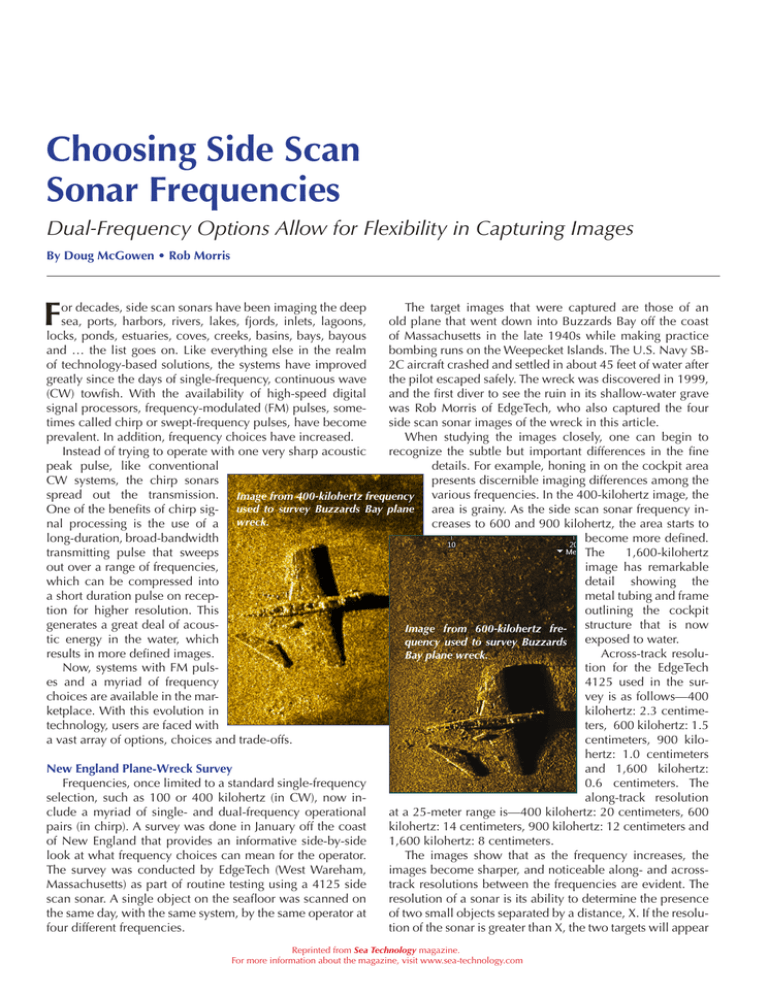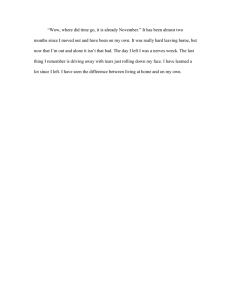
Choosing Side Scan
Sonar Frequencies
Dual-Frequency Options Allow for Flexibility in Capturing Images
By Doug McGowen • Rob Morris
F
or decades, side scan sonars have been imaging the deep
The target images that were captured are those of an
sea, ports, harbors, rivers, lakes, fjords, inlets, lagoons,
old plane that went down into Buzzards Bay off the coast
locks, ponds, estuaries, coves, creeks, basins, bays, bayous
of Massachusetts in the late 1940s while making practice
and … the list goes on. Like everything else in the realm
bombing runs on the Weepecket Islands. The U.S. Navy SBof technology-based solutions, the systems have improved
2C aircraft crashed and settled in about 45 feet of water after
greatly since the days of single-frequency, continuous wave
the pilot escaped safely. The wreck was discovered in 1999,
(CW) towfish. With the availability of high-speed digital
and the first diver to see the ruin in its shallow-water grave
signal processors, frequency-modulated (FM) pulses, somewas Rob Morris of EdgeTech, who also captured the four
times called chirp or swept-frequency pulses, have become
side scan sonar images of the wreck in this article.
prevalent. In addition, frequency choices have increased.
When studying the images closely, one can begin to
Instead of trying to operate with one very sharp acoustic
recognize the subtle but important differences in the fine
peak pulse, like conventional
details. For example, honing in on the cockpit area
CW systems, the chirp sonars
presents discernible imaging differences among the
spread out the transmission. Image from 400-kilohertz frequency various frequencies. In the 400-kilohertz image, the
One of the benefits of chirp sig- used to survey Buzzards Bay plane area is grainy. As the side scan sonar frequency innal processing is the use of a wreck.
creases to 600 and 900 kilohertz, the area starts to
long-duration, broad-bandwidth
become more defined.
transmitting pulse that sweeps
The
1,600-kilohertz
out over a range of frequencies,
image has remarkable
which can be compressed into
detail showing the
a short duration pulse on recepmetal tubing and frame
tion for higher resolution. This
outlining the cockpit
generates a great deal of acousstructure that is now
Image from 600-kilohertz fretic energy in the water, which
exposed to water.
quency used to survey Buzzards
results in more defined images.
Across-track resoluBay plane wreck.
Now, systems with FM pulstion for the EdgeTech
es and a myriad of frequency
4125 used in the surchoices are available in the marvey is as follows—400
ketplace. With this evolution in
kilohertz: 2.3 centimetechnology, users are faced with
ters, 600 kilohertz: 1.5
a vast array of options, choices and trade-offs.
centimeters, 900 kilohertz: 1.0 centimeters
New England Plane-Wreck Survey
and 1,600 kilohertz:
Frequencies, once limited to a standard single-frequency
0.6 centimeters. The
selection, such as 100 or 400 kilohertz (in CW), now inalong-track resolution
clude a myriad of single- and dual-frequency operational
at a 25-meter range is—400 kilohertz: 20 centimeters, 600
pairs (in chirp). A survey was done in January off the coast
kilohertz: 14 centimeters, 900 kilohertz: 12 centimeters and
of New England that provides an informative side-by-side
1,600 kilohertz: 8 centimeters.
look at what frequency choices can mean for the operator.
The images show that as the frequency increases, the
The survey was conducted by EdgeTech (West Wareham,
images become sharper, and noticeable along- and acrossMassachusetts) as part of routine testing using a 4125 side
track resolutions between the frequencies are evident. The
scan sonar. A single object on the seafloor was scanned on
resolution of a sonar is its ability to determine the presence
the same day, with the same system, by the same operator at
of two small objects separated by a distance, X. If the resolufour different frequencies.
tion of the sonar is greater than X, the two targets will appear
Reprinted from Sea Technology magazine.
For more information about the magazine, visit www.sea-technology.com
as one in the sonar image.
If the resolution is less than or
equal to X, the target should
be resolved into two distinct
targets in the image.
Normally, when using
long pulses, even at a higher
frequency, the resolution of
the seabed is lost. However,
with good chirp processing
and high-frequency bands,
resolution of the seabed and/
or objects on the seabed is
obtained after correlation processing of the received signal.
Image from 900-kilohertz frequency
used to survey Buzzards Bay plane
wreck.
Choosing Frequencies
Image from 1,600-kilohertz freWith so many frequency opquency used to survey Buzzards Bay
tions available in the marketplace
plane wreck.
today, the question of material
differences often comes to the
forefront. As shown in the images
here, frequency can make a difference and should be thoughtfully reviewed by side scan sonar
operators.
Although the 1,600-kilohertz
frequency image is clearly superior to the lower-frequency
images, consideration must be
given to an operator’s mission
and goals. While the 1,600 kilohertz produces a very good
high-resolution image, one could choose to trade-off a bit of
resolution to get a bit more range and wider swath, depending on the mission goals. If the ability to do vast wide area
searches in deep water is the goal, a lower-frequency system
with greater swath coverage is the best choice.
The trade-off of high-frequency, high-resolution surveys
and lower-frequency, large-coverage surveys should be
taken into account by an operator. One benefit with the
technologically advanced systems of today is that most systems now come with a choice of frequency pairs. The lower
frequency in the pair can provide the wide swath coverage
needed, while the higher frequency can provide great resolution. A system that will operate both frequencies simultaneously will offer an advantage. n
Doug McGowen is the director of new business development and marketing at
EdgeTech. He has 20 years of experience in product development strategy and
the promotion of technology-based products and solutions, including side scan
sonars and sub-bottom profilers. He has a bachelor’s in business and economics, and an M.B.A.
Rob Morris is the EdgeTech customer service manager. He has field experience performing underwater surveys, and training field personnel on side scan
sonars and sub-bottom profilers. With more than 20 years of experience, he has
completed underwater surveys worldwide. He is also a certified scuba-diving
instructor and skilled ROV operator.
©Copyright 2013 by Compass Publications Inc. Sea Technology (ISSN 0093-3651) is
published monthly by Compass Publications Inc., Suite 1010, 1600 Wilson Blvd., Arlington,
VA 22209; (703) 524-3136; oceanbiz@sea-technology.com. All rights reserved. Neither this
publication nor any part of it may be reproduced, stored in a retrieval system, or transmitted
in any form or by any means, electronic, mechanical, photocopying, recording, or otherwise,
without the prior permission of Compass Publications Inc.




